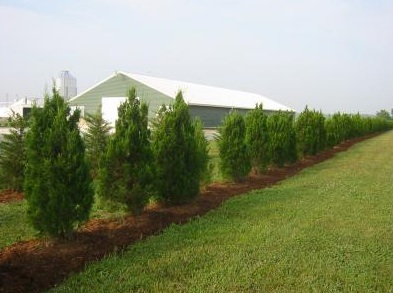
 NEWS HIGHLIGHT
NEWS HIGHLIGHT
Trees kill odors and other emissions from poultry farms
Planting just three rows of trees around a poultry farm can cut
nuisance emissions of dust, ammonia, and odors from poultry houses and
aid in reducing neighbor complaints, according to scientists from the
University of Delaware.
August 22, 2008, Philadelphia, PA — Planting just three rows of trees around a poultry farm can cut nuisance emissions of dust, ammonia, and odors from poultry houses and aid in reducing neighbor complaints, according to scientists from the University of Delaware.
 Some of the emissions were cut by almost half, according to Dr. George W. Malone and his colleagues who presented their information at the 236th National Meeting of the American Chemical Society (ACS). Trees also provide farms with the added benefit of reducing energy consumption, he noted.
Some of the emissions were cut by almost half, according to Dr. George W. Malone and his colleagues who presented their information at the 236th National Meeting of the American Chemical Society (ACS). Trees also provide farms with the added benefit of reducing energy consumption, he noted.
Dr. Malone, who is an extension poultry specialist with the University of Delaware, points out that trees have been used in the past as aesthetic barriers. His research on giving trees a new role in the poultry industry began in 2000, when residents near farms on the Delmarva Peninsula in Delaware, Maryland and Virginia complained about dust and odors from poultry houses that had recently switched to new ventilation systems.
In the report, Dr. Malone’s team suggested that planting vegetation could reduce ammonia and particulates that may degrade surrounding air and water quality.
“We were aware of the concerns locally,” said Dr. Malone. “We looked at what we could do to address them and the whole area of air quality as it relates to the emission of ammonia from poultry houses.”
In response, they proposed planting trees to serve as a vegetative filter that could capture emissions from these family farms, which individually can house an average of 75,000 chickens. In a six-year study, Dr. Malone and his team found that a three-row plot of trees of various species and sizes reduced total dust by 56 percent, ammonia 53 percent, and odor 18 percent. The approach is being adopted around the Delmarva.
The research showed that as vegetative “filters,” not all trees are created equal.
“We’ve certainly been on a learning curve since 2001 about the different plant materials suitable for this practice. We typically recommend the first row nearest the fans to be either a deciduous tree or a tree with a waxy leaf surface and the other two rows be an evergreen,” Dr. Malone said. “It’s very important to realize there are a number of criteria that you use in tree selection and planting design. What works for our soil types and climate on the Delmarva Peninsula may not be suitable for other locations.”
Certain species of trees can grow eight to 10 feet per year, Dr. Malone said, which allows for a quick start in creating a buffer. “One initial concern was that it takes years for trees to grow to become effective in filtering out poultry house emissions, but that’s not necessarily the case.”
Trees reduce poultry house emissions by capturing dust, ammonia and odors in their leaves. They also aid in dispersion of emissions, which reduces the impact on neighbors.
Another factor intensifying the need for environmentally friendly agricultural practices has been the rapid growth of residential development in poultry-producing areas. “Planting trees demonstrates that the poultry grower is being proactive to address potential concerns of neighbors, gives the poultry farm a landscape appearance and increases property values. Adding the vegetative buffers also helps to reduce noise associated with farm operations,” he said.
Today, about 35 percent of Delmarva Peninsula’s 2,000 farms have developed vegetative buffers, making this region the first in the country to adopt a widespread comprehensive vegetative buffer program, Dr. Malone said.
The living filter system also has other benefits, Dr. Malone noted. For instance, it conserves energy by increasing shade and cooling in the summer and acts as a buffer to reduce heating costs in the winter.
Not only do trees enhance air quality, they also improve the water quality around poultry farms because they can filter pollutants from soil and groundwater.